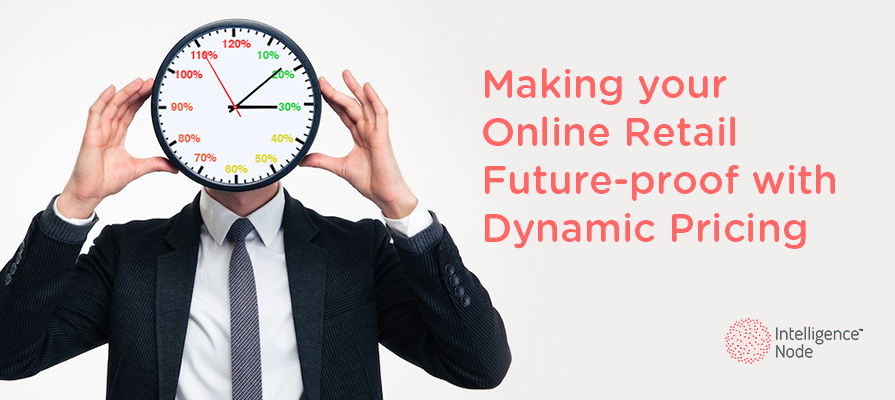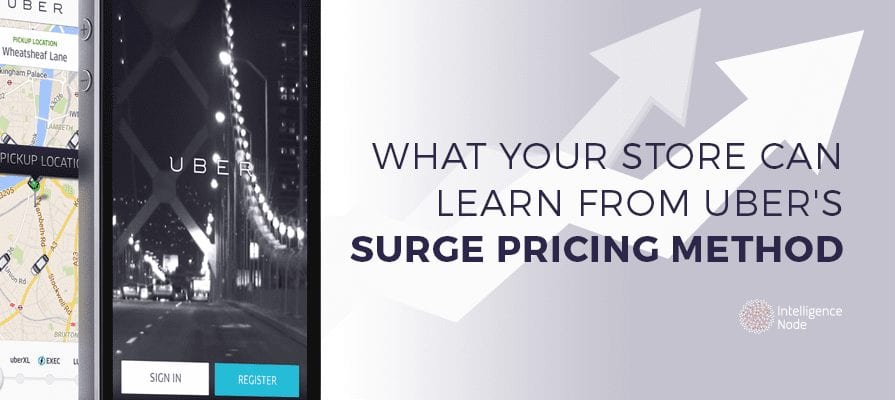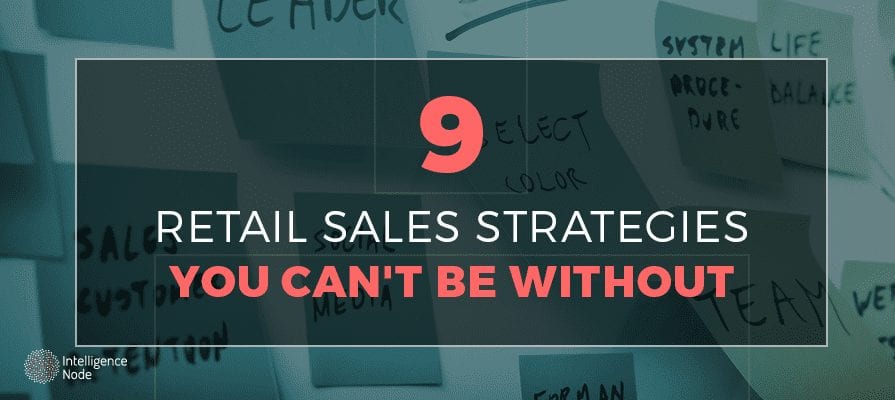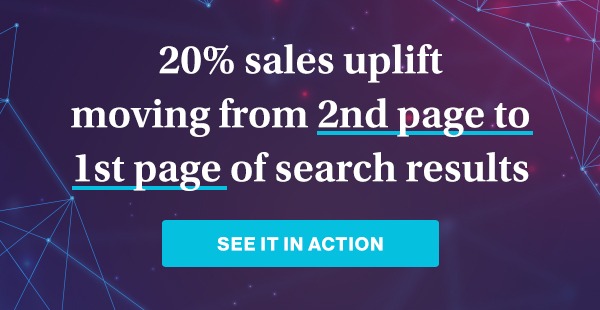What is Dynamic Pricing?
Dynamic pricing strategy is a flexible pricing method where prices of certain products or services are changed daily or multiple times a day based on competitor price movements and market trends. A dynamic pricing strategy uses variable prices instead of fixed prices to increase margins and sales.
In the old days, fixed prices were the norm in the absence of price monitoring tools and the availability of competitor data. Prices changed seasonally or during certain retail holiday periods. And this worked back then as everybody followed a similar approach and shoppers didn’t expect much else. But that’s changed now. Today prices change in minutes, not days or weeks. Competitors use the large amounts of consumer and competitor data they have access to, to make pricing decisions on a daily basis. Consumers too expect to see discounts and deals at all times rather than during particular sale periods. This new flexible pricing phenomenon is dynamic pricing.
But, in order to successfully implement a dynamic pricing strategy, businesses need large amounts of data. And it doesn’t end there. They need accurate, real-time data in an actionable format that can influence decisions in an analytical way. They cannot depend on manual processes or intuition to make these pricing decisions – which in the case of large retailers could amount to thousands per day.
Why has Dynamic Pricing Gained Popularity in Retail?
The eCommerce industry has gained unprecedented momentum in the last few years. COVID further accelerated the shift to eCommerce and competition and demand both saw a huge uptick. Shopper expectations soared and price-sensitive shoppers increased as consumers got access to comparison apps and multiple options to choose from. These price-sensitive, comparison shoppers review and compare prices across channels to find the best deals. They often hold low prices in higher importance than brand loyalty while making a purchase decision. To convert these shoppers, competitive prices are key. And the answer to competitive prices lies in dynamic pricing.
It helps brands and retailers review and optimize prices in line with competitors multiple times a day. This strategy helps them offer competitive pricing without compromising on margins, thus increasing sales and conversions. Amazon has maintained its position as the market leader with this very pricing strategy and many retail giants are following suit by incorporating dynamic pricing into their strategic decisions.
Dynamic Pricing Examples and Use Cases
This strategy isn’t new at all. It has been around for quite some time and has been a popular strategy across industries like hotels, airlines, and even stock markets. It’s a tactic used to grab the customer’s attention and so far, it’s proven to be extremely successful.
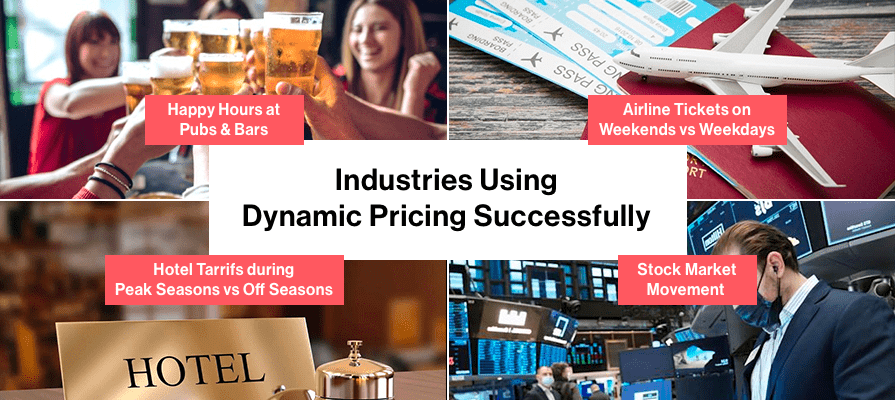
Here are a few examples of how dynamic pricing has influenced different economies.
- The concept of “Happy hours” in a bar has been popular for years. Happy hours is nothing but a type of dynamic pricing strategy. By slashing prices during low traffic hours, it helps attract more customers, encourages them to buy more drinks as prices are low, and results in much higher sales and revenue for the restaurant or the pub. It has proved to be so effective that most bars and pubs are still using this strategy today.
- The stock market operates on the basis of shared values rising and falling. Similar to the concept of dynamic pricing, the value of shares is calculated by considering initial conditions, demand, and a few other parameters. This includes the company’s actions and the state of the economy. So, the prices are adjusted to make the most of the current situation.
- Take airline ticket prices. You can see that they operate along the same line. During the weekends and holidays, prices are indefinitely higher than on regular weekdays since more people are inclined to travel during these times. And as pricing algorithms have become more sophisticated, as airline ticket searches increase for a particular day, the prices immediately increase in response to the demand.
What’s Changed Now?
Dynamic pricing use cases have increased and this strategy is getting adopted across multiple industries – a key example being retail. You might wonder why it only gained momentum in retail recently when the concept was around for quite some time.
There are multiple reasons why:
- Dynamic pricing cannot be implemented manually, at scale
- It needs vast amounts of real-time, accurate, and reliable competitor and market data
- Companies need advanced algorithms and custom, rule-based pricing solutions for implementing a successful dynamic pricing strategy
- Retailers and brands need organizational flexibility to make quick dynamic pricing decisions
- Its is a continuous process that needs constant evaluation and analysis for the highest returns
With the advancement of technology and availability of advanced dynamic pricing vendors in the market, the adoption and trust of this pricing strategy has increased and it is becoming more mainstream as we speak.
Retailers’ Hesitation with Dynamic Pricing Software
With any new technology in the market, there is always hesitation from the users in the beginning – either because they don’t understand the technology behind the product or service or they find it risky, with little evidence to back its success. Similar was the case with eCommerce dynamic pricing solutions until recently.
And that is not all, for pricing solutions, retail businesses need to change their strategy from an intuition-based and manually driven strategy to a data-driven one. It requires a process transformation and a greater trust in competitive data rather than basing decisions on a whim or on historic prices alone. But, as dynamic pricing is becoming more recognized, retailers’ hesitation about its capability and usefulness is fast diminishing.
Amazon’s success with Dynamic Pricing
Amazon has had tremendous success in applying dynamic pricing to its products. Other retailers are still attempting to beat Amazon in this field. This is one of the key reasons why Amazon has continued to maintain its position as the market leader. It uses sophisticated dynamic pricing algorithms to continuously evaluate, review, and update the prices of millions of its products multiple times a day. And by doing so, it is able to offer the most competitive prices to its shoppers, ensuring retention and brand loyalty.
“ It takes Amazon two minutes to make a price change! Is your price right?”
Popular Pricing Strategies
1. Competitor based dynamic pricing
This is the most commonly implemented pricing strategy where prices are changed based solely on prices offered by competitors.
2. Elasticity based dynamic pricing
Elasticity based pricing uses demand and supply to set prices of a product. When demand is higher than supply, prices increase and vice versa.
3. Cost-plus dynamic pricing
This is the simplest of pricing strategies where price of a product is determined by taking the cost price and adding a desired profit margin on top of it.
Pricing solutions often enable retailers to combine these pricing strategies to determine the best prices. Advanced pricing solutions also incorporate other parameters such as stock availability, best-selling SKUs, and zip code level price movements.
Dynamic Pricing Implementation
Implementing dynamic pricing is a long and continuous process. It requires organizations to upgrade their processes and increase their data dependability. It is usually implemented in 4 steps. For successful implementation of the pricing strategy, it is important for businesses to first establish their commercial goals, business objectives, and brand positioning. Let’s look at the different steps to dynamic pricing implementation:
1. Identify your business and commercial goals
The first step in the journey to dynamic pricing implementation is to define your business and commercial objectives. Is the end goal to increase sales by slashing prices or is it to increase product margins with sales as a secondary objective? After closely reviewing your objectives, you can then decide the strategy you want to adopt for your dynamic pricing.
2. Decide your pricing strategy
Once you have set your goals, it’s time to choose your pricing strategy. Depending on your goals you can go with a competitive, elastic, or cost-plus pricing strategy. If you want to ensure you offer the lowest prices amongst your competitors, a competitor based pricing strategy would be an ideal choice.
3. Identify products for dynamic pricing
Dynamic pricing does not have to be implemented as a blanket strategy for the entire product portfolio. It is a strategy that changes for every product and hence you have the flexibility to choose which products you want to implement dynamic pricing strategy for. In this step, you need to identify product candidates for dynamic pricing. It could be your best-selling products or products that you want to increase sales or margins for. If you are a seasoned player in the dynamic pricing ecosystem, you could also decide to utilize this pricing strategy for all your products.
4. Set dynamic pricing rules
Once you have identified SKUs for dynamic pricing, the next step is to define and set pricing rules. These rules form the basis for price changes that your pricing engine will make. Pricing rules need to be created for every product that you want to track and optimize prices for. Your dynamic pricing is now all set!
5. Evaluate the success of your pricing strategy
While the pricing engine does its work reviewing and optimizing your product prices, it doesn’t end there. You need to constantly evaluate the performance of your products, analyze if the pre-defined rules are working and are helping achieve your goals, and amend your rules and strategy to stay on the defined path.
Read More : 10 Tested eCommerce Pricing Strategies for Long Term Profitability
How Customers Make A Decision
When a person finds a product on sale, that’s something that tells them that they should be ready to make a purchase. The person must have previously browsed through several products. This information is collected and dynamic pricing is applied to other similar products. This is the result of the algorithms and dynamic pricing.
When the customer finds the desired product at a discounted price, it’s natural for them to make a purchase. This naturally increases the sales that you generate.
Final Word
The retail economy has changed and so have consumer preferences and expectations with it. While dynamic pricing has its pros and cons, the pros heavily outweigh the cons in the current retail landscape where prices define conversions more than any other parameter. This also ensures transparent, fair pricing and helps consumers grab the best deals available on the market. Retailers and brands need to ride the dynamic pricing wave to future-proof their businesses, compete against retail giants, and ensure a steady stream of sales, repeat consumers, and profits.
